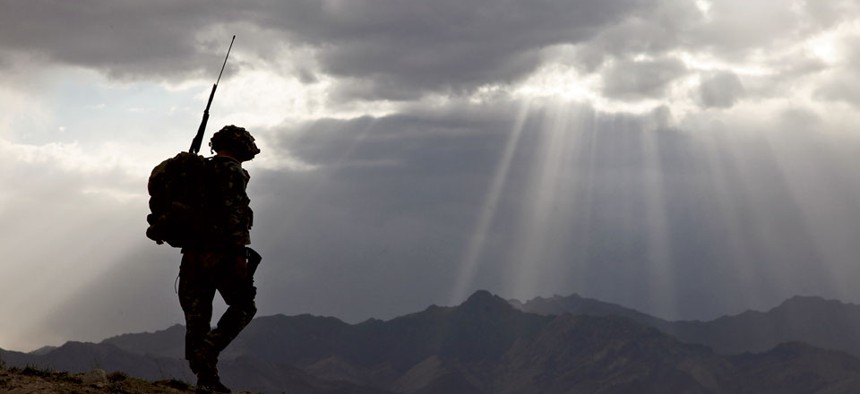
Russell Gilchrest/U.S. Army
Fighting The Future Enemy
The Army’s vision of war in 2030 poses the challenge of innovation without costly new weapons.
Even with new innovations and evolving threats, the Army’s vision of what war might look like and the challenges troops would face in 2030 isn’t all that different than it is today.
Army leaders recently conducted a “deep future” war game to play out a military conflict 15 years from now, coined “Unified Quest,” and held at the U.S. Army War College in Carlisle Barracks, Pa. Defense One was invited to listen in as dozens of Army brass and civilian and foreign counterparts conducted an after-action review at the National Defense University in Washington.
Here’s the scenario they used: There’s been a chemical attack inside the United States and the terrorists responsible for the deadly attack are from a nuclear-armed landlocked nation surrounded by less than supportive neighbors.
The U.S. military has strong ties with one of the enemy’s bordering neighbors, who also happens to have a port, and through a “coalition of the willing” and a U.N. Security Council vote approving military action, other bordering nations offer access as well. The Marines swoop in, followed by several divisions of a now smaller Army. Navy ships steam toward the region.
The United States is still facing budget constraints in 2030 and the Army is leaner, doing more with less, but there have been investments in new innovations on the battlefield in the service’s best-case scenario. There are ground combat vehicles that weigh just 30 tons, helicopters that can fly faster and longer, extended-range missiles and ammunition with advanced sensors, hybrid-powered rechargeable equipment and a massive vertical lift aircraft capable of moving an entire battalion.
It takes the Army 15 days to get in. The mission is to secure and stabilize the enemy’s cache of chemical weapons. There’s plenty of combat, but within 24 days, there’s a cease-fire and the WMDs are secured. But the enemy regime remains in power. The war game ended there and did not address whether U.S. soldiers stayed to hold their gains or do any post-conflict nation-building operations or whether they simply turned around and went home. There were major shortages of fuel, and being lighter and more maneuverable paid off at first, but the Army’s tail quickly became difficult to build and sustain.
That was one scenario.
But knowing that most of these imagined and costly new weapons and vehicles are unlikely to debut on the battlefield in the next 15 years, Army officials simultaneously played out a second 2030 scenario without their wish list. The results were markedly different. This time, it took about seven weeks to enter the imaginary country, and after 85 days of combat the WMDs were lost.
What’s interesting to note is the enemy the Army sees itself fighting. Despite the Pentagon’s much-touted pivot to the Asia-Pacific region, the Army’s future adversary resembles Syria and Pakistan more than China or North Korea. The 2030 war game isn’t all that different from what unfolded last summer as President Obama stared down the Assad regime after it used chemical weapons. While there was never a threat of putting American boots on the ground and no direct attack against the United States, many of the challenges are the same.
Army leaders say being lighter and faster helps. “Speed created more time to make decisions,” one official says. One lesson learned: The Army wants to move faster at setting up secure communications without all the bulky equipment that comes with it. Leaders want to find a way to harness private sector capabilities with military-grade security, seeing a future in which a soldier can talk to his commanders using only an iPhone. “Al Qaeda is doing it. Hezbollah is doing it. They leverage existing networks. Five to six years from now, that’s what I want,” one official says. “That’s the kind of innovation we need.”
The problem, even in 2030, is logistics. “What’s the point of having 21st century equipment when you have 20th century logistics?” another official says.
The Army of the future also sees its soldiers serving repeated rotations in the same geographic regions to boost their expertise; linguistics will be a critical skill as well. Another key to success leaders already know will be to build and maintain strong ties with militaries around the world, so when a crisis erupts they’re already there. And even if a 30-ton vehicle or a vertical lift that can move a battalion probably won’t be available in 15 years, the Army knows it must innovate and reshape after fighting two long, massive ground wars. The enemy might not be that different in 2030, but the economic climate has changed.
“We have no choice but to innovate,” one leader says, “because of the budget.”
NEXT STORY: This Is Your Brain On Hold







